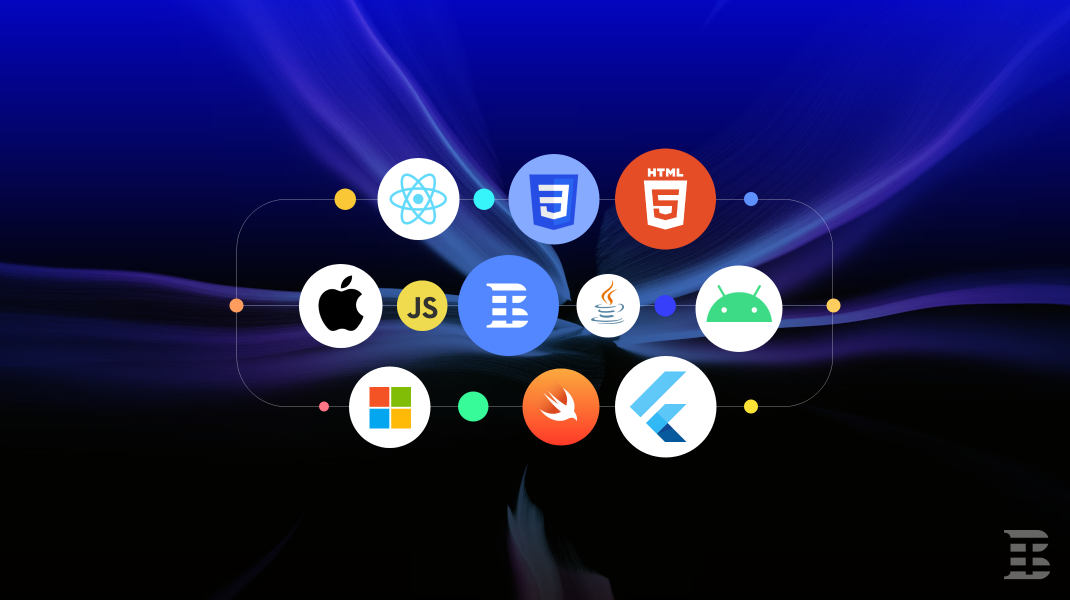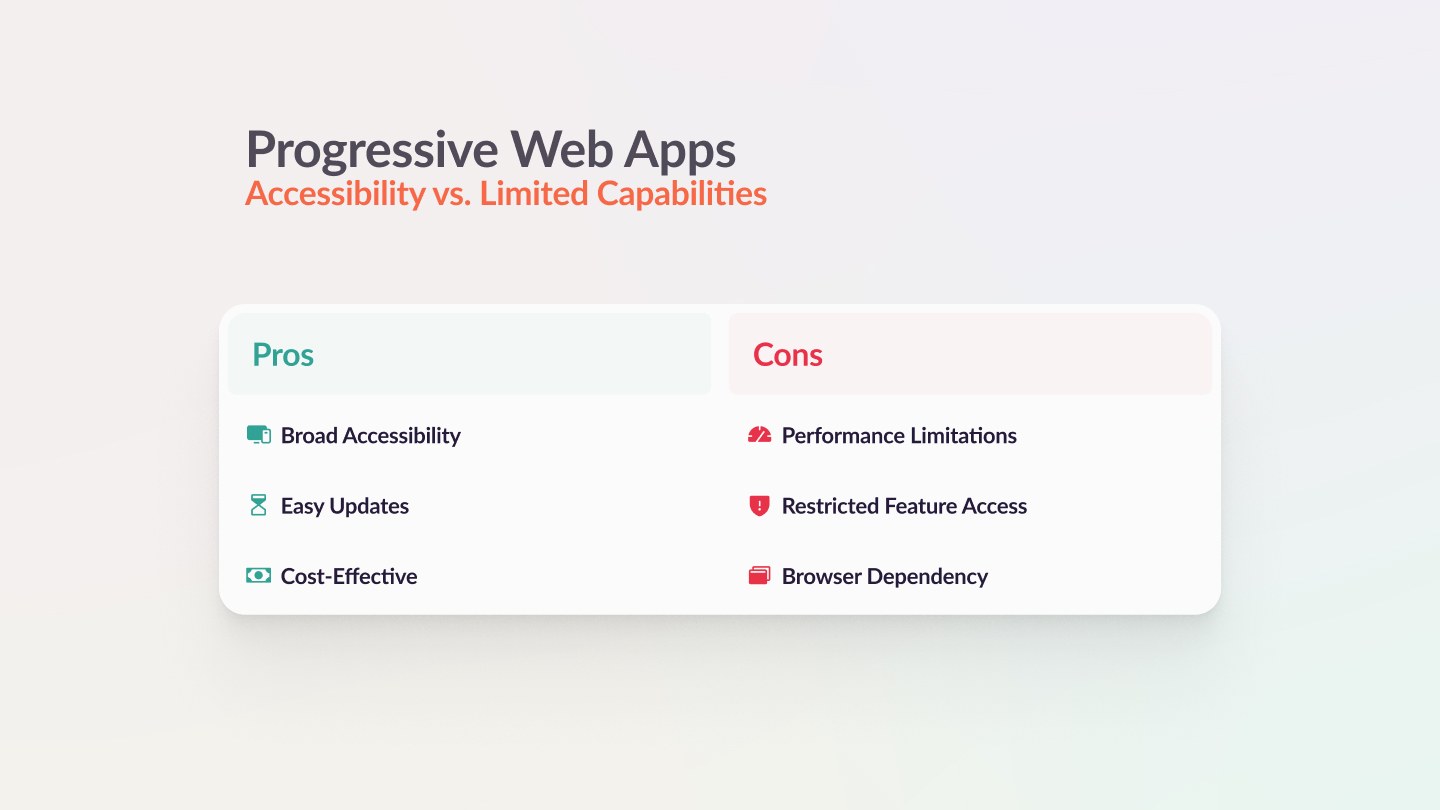Native vs. Hybrid vs. Cross-Platform vs. Progressive Web Apps

Mobile app development is a key driver in the tech industry, shaping how businesses and consumers interact in the digital space. The economic and practical significance of mobile apps is evident in recent data. In Q3 2023, consumers spent an impressive 33.9 billion USD on mobile apps, highlighting their growing influence in the digital market. The volume of app downloads further illustrates this trend, with over 250 million apps downloaded daily between 2019 and 2020, totaling more than 91 billion downloads annually.
This article focuses on the three main types of mobile applications: Native, Hybrid, Cross-Platform, and Progressive Web Apps (PWAs). Each category has its own set of advantages and challenges, making the choice between them crucial for developers and businesses. We'll delve into what sets these app types apart, their benefits and drawbacks, and real-world case studies. The aim is to equip you with the knowledge to make informed decisions for your mobile app development projects.
Exploring Native, Hybrid, Cross-Platform, and Progressive Web Apps
In the realm of mobile app development, understanding the differences between native, hybrid, cross-platform, and progressive web apps is crucial for choosing the right approach.
Native Apps: Platform-Specific Powerhouses
Native apps are developed for specific mobile operating systems like iOS or Android. They utilize the device's hardware and software to their fullest, resulting in high performance and a smooth user experience. Examples include iOS apps written in Swift or Objective-C and Android apps in Java or Kotlin. The downside is the need for separate development for each platform, increasing time and cost.
Hybrid Apps: Versatile and Cost-Effective
Hybrid apps blend web and native app features. Created with web technologies (HTML, CSS, JavaScript) and wrapped in a native container, they can use some device features and offer a near-native user experience. Platforms like Ionic and Cordova are popular for developing hybrid apps. They provide cross-platform compatibility, reducing development time and costs, but may have limitations in performance and user experience compared to native apps.
Cross-Platform Apps: Uniformity Across Devices
Cross-platform apps are designed to run on multiple mobile operating systems from a single code base, but they are compiled into native code, which can offer better performance compared to hybrid apps. Flutter, renowned as the most popular cross-platform mobile framework in 2023, enables developers to build visually appealing and natively compiled applications for mobile, web, and desktop from a single codebase. Xamarin is another cross-platform mobile app framework. This approach saves development time and ensures consistency across different platforms. However, while offering better performance than hybrid apps, they might still lag behind native apps in terms of accessing device-specific features and overall smoothness.
Progressive Web Apps (PWAs): The Browser-Based Approach
PWAs are advanced websites that mimic native app functionality. Accessible through web browsers and built using web technologies, they bypass the need for app store downloads. PWAs, like those built using Angular, React, or Vue.js, work on any platform with a compliant browser. They can function offline and send push notifications, appealing to businesses seeking broad reach without the hefty development cost of native apps. However, performance and access to device-specific features are limited compared to native or even cross-platform apps.
Each app type, be it native for its performance, hybrid for its versatility, cross-platform for its uniformity, or PWAs for their accessibility, has distinct advantages and challenges. The choice largely depends on your project’s requirements, target audience, and resource availability.
Pros and Cons of Different App Development Approaches
Choosing the right development approach for a mobile app involves weighing the advantages and disadvantages of each type. This section provides a comparative analysis of native, hybrid, cross-platform, and progressive web apps.
Native Apps: Optimized Performance vs. Resource Intensity
Pros:
-
Optimal Performance: Leveraging device-specific hardware, native apps offer the best performance and user experience.
-
Native Feature Access: Full access to device features and capabilities, like camera, GPS, and sensors.
-
Better UX: Ability to create a highly responsive and intuitive user interface that aligns with the platform's standards.
Cons:
-
Higher Costs: Separate development for each platform (iOS, Android) can lead to increased costs.
-
Longer Development Time: Developing and maintaining code for multiple platforms takes more time.
-
Platform Dependency: Any updates or changes must be made separately for each version of the app.

Hybrid Apps: Flexibility vs. Compromised Experience
Pros:
-
Cross-Platform Compatibility: Write once, run anywhere approach saves time and resources.
-
Cost-Effective: Lower development and maintenance costs compared to native apps.
-
Access to Device Features: Ability to access some native features through plugins.
Cons:
-
Performance Issues: May not perform as well as native apps, especially with complex or graphics-heavy applications.
-
Limited User Experience: The user experience might not fully match that of a native app.
-
Dependency on Frameworks: Reliant on third-party platforms like Ionic, Cordova, or Xamarin.

Cross-Platform Apps: Consistency vs. Performance Nuances
Pros:
-
Uniformity Across Platforms: Single codebase for multiple platforms ensures consistency.
-
Faster Development: Saves time in coding and testing across different operating systems.
-
Cost-Effective: Reduces the cost of maintaining separate codebases for each platform.
Cons:
-
Performance Trade-Offs: While better than hybrid, may still fall short of native app performance.
-
Limited Customization: Certain platform-specific features might be challenging to implement.
-
Framework Dependence: Tied to frameworks like Flutter, which might limit certain functionalities.

Progressive Web Apps: Accessibility vs. Limited Capabilities
Pros:
-
Broad Accessibility: No need for app store downloads; accessible via web browsers.
-
Easy Updates: Updates are straightforward, similar to a website.
-
Cost-Effective: Lower development costs compared to native apps.
Cons:
-
Performance Limitations: Not as powerful as native apps, particularly for complex tasks.
-
Restricted Feature Access: Limited ability to access certain device-specific features.
-
Browser Dependency: Performance and features can vary depending on the browser and device.

In summary, each app development approach has its unique set of strengths and weaknesses. Native apps lead in performance, hybrid, and cross-platform apps offer cost and time efficiency with some trade-offs, and PWAs provide ease of access and maintenance. The choice should align with your project's specific needs, target audience, and budget constraints.
Case Studies: Diverse Strategies in Mobile App Development
The practical application of different mobile app development approaches can be best understood through real-world case studies. Here, we explore examples from native, hybrid, cross-platform, and progressive web apps.
Native Apps: Duolingo's Language Learning Experience
Duolingo, a language learning platform, originally developed its Android app using Java, later transitioning to Kotlin for improved developer productivity and happiness. This migration maintained the app's codebase size while supporting new features and more active contributors. Similarly, Duolingo's iOS app benefits from the Swift programming language, enhancing developer experience and offering a robust, platform-specific application.
Hybrid Apps: MarketWatch's Financial Intelligence
MarketWatch, a news and market data app, chose Ionic for its hybrid platform. The development team leveraged Ionic's web views, custom OAuth solutions, and Urban Airship for notifications. Despite some challenges with plugin updates and iframe content management, the team valued Ionic for its performance, elegant transitions, and ability to leverage existing web technologies. This approach enabled the MarketWatch app to deliver a robust experience across both iOS and Android platforms.
Cross-Platform Apps: My BMW App's Seamless Integration
BMW leveraged Flutter for their My BMW App to ensure uniform functionality across iOS and Android platforms. Recognizing the growing disparities between their iOS and Android offerings, BMW's team focused on creating a developer-friendly and scalable platform. This approach allowed them to release products across all brands and regions simultaneously. Flutter enabled BMW to manage a single codebase, significantly reducing the development time and ensuring feature parity across platforms.
Progressive Web Apps: Trivago's Enhanced Booking Experience
Trivago, a hotel search engine, opted for a Progressive Web App to better serve its increasing mobile user base. Facing challenges with mobile connectivity and app download reluctance, Trivago's PWA provided features like push notifications and offline access. This approach led to a 150% increase in user engagement and significantly higher click-through rates for hotel offers. The PWA format allowed Trivago to overcome limitations inherent in native apps, particularly in terms of reach and accessibility.
These case studies from Duolingo, Discord, BMW, and Trivago illustrate the impact of selecting the appropriate app development strategy. Each company's choice was influenced by its unique requirements, highlighting the importance of aligning the app development approach with specific business goals and user needs.
Navigating the Decision-Making Process in Mobile App Development
Selecting the right type of mobile app development strategy is a decision that hinges on various factors. To make an informed choice, consider the following key aspects:
-
Target Audience and Market Needs: Understand the preferences and technical capabilities of your target users. Analyze market trends and competitor strategies.
-
Feature Requirements: Evaluate the complexity and nature of the features you intend to include. Native apps excel in performance-intensive features, while PWAs are suited for less complex, broader-reach applications.
-
Development Time and Resources: Assess the availability of resources, including time and budget. Cross-platform and hybrid approaches can reduce development time and costs.
-
Maintenance and Scalability: Consider the long-term maintenance requirements and scalability. Native apps may require more effort in updates and maintenance across multiple platforms.
-
Performance Expectations: Determine the level of performance required. For high-performance, graphically intense applications, native development is preferable.
-
Platform Specifics: Consider platform-specific guidelines and capabilities, especially if your app needs to leverage specific hardware features of mobile devices.
-
Future-Proofing: Think about the future trajectory of your app. Technologies and user expectations evolve, so choose a development approach that can adapt to future changes and innovations.
Looking Ahead in Mobile App Development
As we wrap up our exploration of mobile app development, it's clear that the landscape is continuously evolving. Future trends point towards even more immersive and interactive experiences, with technologies like AI, machine learning, and AR/VR becoming increasingly integrated into mobile apps. We're also witnessing a growing emphasis on privacy and security, driven by user concerns and regulatory changes.
Moreover, the rise of 5G technology is set to unlock new possibilities in app performance and functionalities, potentially shifting the dynamics between different app development approaches.
Ultimately, the choice between native, hybrid, cross-platform, and PWAs will continue to be shaped by technological advancements, user expectations, and business objectives. Staying informed and adaptable will be key to navigating the future of mobile app development successfully.